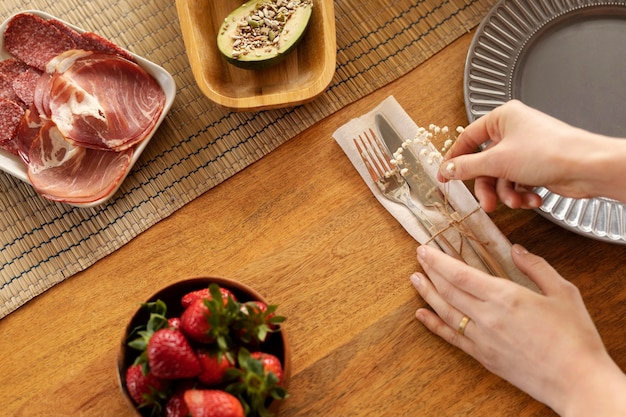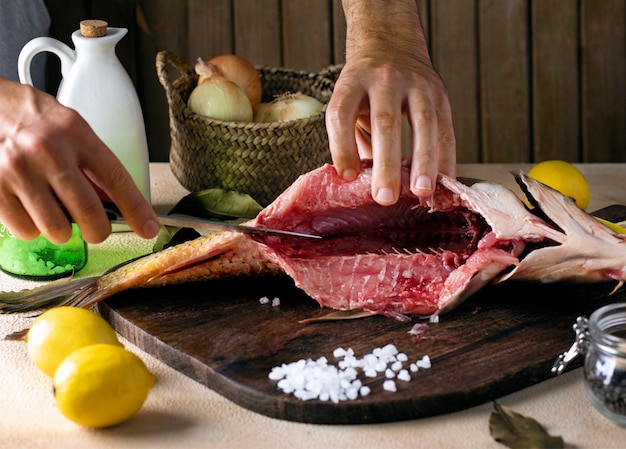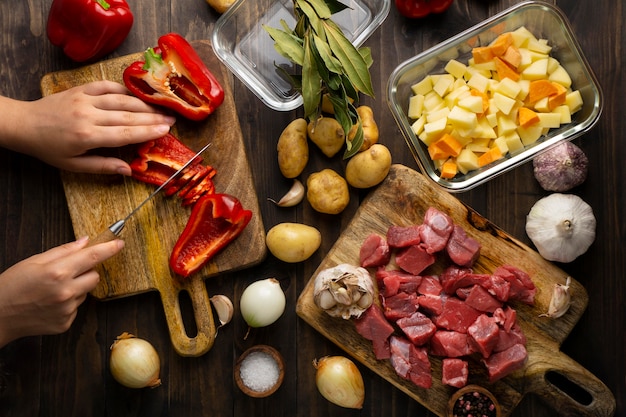(Part 1) The Perfect Cut: Finding Your Steak Soulmate

Choosing the Right Beef Fillet: A Matter of Marbling
First, look for a piece of beef fillet that's well-marbled. This means it has a good amount of fat running through the lean meat, which is absolutely essential for juicy, flavourful results. Imagine it like this: the fat acts like a natural moisturiser for the meat, keeping it succulent and tender as it cooks. You'll want to avoid any pieces that look dry or have a lot of sinew, which can be tough and chewy.I'm a big fan of British beef, especially from local farms. It tends to have a richer flavour and a lovely, tender texture. But, of course, if you can't get your hands on British beef, don't worry! American or Australian cuts can be equally delicious. Just make sure it's from a reputable butcher who knows their stuff.The Size of the Beef Fillet: From Solo to Feast
The ideal size really depends on your needs. For a smaller meal, a 1-2 inch thick fillet is perfect. It's a lovely, manageable size for a romantic dinner or a quick weeknight meal. But if you're cooking for a crowd, go for a thicker cut, perhaps 3 inches or more. Think of it as a grand gesture of culinary hospitality, a majestic centrepiece for a memorable dinner party.Remember, thicker cuts take longer to cook, so plan accordingly. And if you're feeling adventurous, why not try a whole fillet? It's a real statement piece and makes a fantastic centrepiece for any dinner party. Imagine the oohs and ahhs when you bring it to the table, glistening and ready to be carved.(Part 2) The Importance of Rest: A Steak's Time to Breathe

Resting Before Cooking: A Temperature Tale
When you take a fillet straight from the fridge, the cold core can create a temperature shock when it hits the hot pan or grill. This can lead to uneven cooking and a tough, dry steak. It's like jumping into a freezing cold pool after a sauna, not exactly a pleasant experience!Here's the deal: take your beef fillet out of the fridge and let it come to room temperature for about 30 minutes before cooking. This allows the meat to warm up evenly, preventing those temperature shocks. You'll notice a difference in the texture and flavour, trust me!The Resting After Cooking: A Time for the Juices to Reunite
Now, after cooking your fillet, it's crucial to let it rest again. Don't jump straight into cutting and serving! Allow the meat to sit for 10-15 minutes before slicing. This gives the juices a chance to redistribute throughout the steak, making it incredibly juicy and tender. Imagine it as the steak's time to recover from the heat, allowing its natural flavours to settle and mingle. Trust me, it's a game changer.(Part 3) Seasoning Perfection: The Art of Adding Flavour

Salt and Pepper: The Foundation of Steak Flavor
Salt and pepper are the foundation of any good steak seasoning. Salt draws out moisture and helps to enhance the natural flavours of the beef. It's like a conductor leading an orchestra of taste buds, bringing out the best in the meat. Pepper adds a bit of spice and texture, creating a satisfying crunch that complements the tenderness of the steak.Don't be shy with the salt! Season generously just before cooking. The salt will dissolve into the meat, creating a wonderful flavour profile. As for pepper, I like to use a good quality black peppercorn, coarsely ground. It adds a lovely aroma and a satisfying crunch.Beyond the Basics: A Symphony of Flavors
While salt and pepper are essential, you can get creative with other seasonings depending on your taste. I love to add a pinch of garlic powder, onion powder, or even a touch of paprika for a smoky flavour. If you're feeling bold, try a sprinkle of dried herbs like thyme or rosemary. These subtle notes can add depth and complexity to the flavour of your steak.Avoid Overdoing It: Letting the Steak Shine
The key is to keep it balanced. Remember, you don't want to mask the natural flavour of the beef with too many spices. Go for a simple, yet effective seasoning strategy that allows the steak's natural flavours to shine.(Part 4) Mastering the Techniques: From Searing to Roasting
Now for the exciting part: cooking the beef fillet! There are several methods you can choose from, each offering a unique flavour and texture. I'll guide you through my favourites and share some key tips for success.Pan-Seared Beef Fillet: A Classic for a Reason
This is a classic method that's perfect for achieving a beautifully seared exterior and a juicy, tender interior. Imagine a steak that's crisp on the outside and melt-in-your-mouth tender on the inside, a culinary masterpiece! Here's how I do it:1. Heat a heavy-bottomed pan over medium-high heat: This will create a surface hot enough for a perfect sear.2. Add a tablespoon or two of oil: I prefer olive oil or rapeseed oil, but you can choose your favourite. You want the oil to be hot enough to sizzle when you add the beef, like a little culinary fireworks display.3. Carefully place the fillet in the pan: Don't overcrowd the pan – give each piece some space to cook evenly.4. Let the fillet cook undisturbed for about 2-3 minutes per side: This will create a lovely crust and seal in the juices, keeping the steak moist and flavourful.5. Reduce the heat to medium and continue cooking for another 2-4 minutes per side: The exact time depends on how thick the fillet is and your desired level of doneness.6. Use a meat thermometer to check the internal temperature: This is crucial for ensuring the perfect level of doneness. 7. Remove the fillet from the pan and let it rest for 10-15 minutes before slicing and serving: This allows the juices to redistribute, resulting in a juicy and tender steak.Grilled Beef Fillet: The Smoky Embrace of Fire
For a smoky, char-grilled flavour, there's nothing quite like a grilled beef fillet. It's like a steak vacation, full of smoky, caramelized flavour. Here are my tips for success:1. Preheat your grill to medium-high heat: Make sure the grill grates are clean for a pristine sear.2. Season the beef fillet generously with salt and pepper: Don't be shy!3. Place the fillet on the grill and cook for about 4-5 minutes per side: Or until you achieve your desired level of doneness. 4. You can rotate the fillet 90 degrees halfway through cooking to create those beautiful grill marks: They're not just for looks; they also help to distribute the heat evenly.5. Remove the fillet from the grill and let it rest for 10-15 minutes before slicing and serving: Again, this allows the juices to redistribute, ensuring a tender and flavourful steak.roast beef Fillet: A Majestic Feast
If you're cooking for a larger group or want a more impressive presentation, roasting is a great option. It's like the culinary equivalent of a grand entrance, a majestic dish that's guaranteed to impress. Here's what I do:1. Preheat your oven to 400 degrees Fahrenheit (200 degrees Celsius): Get that oven nice and hot for a good sear.2. Season the beef fillet generously with salt and pepper: Remember, salt and pepper are your steak's best friends.3. Place the fillet in a roasting pan and cook for about 15-20 minutes: This creates a nice crust on the outside.4. Reduce the oven temperature to 325 degrees Fahrenheit (160 degrees Celsius) and continue cooking for another 15-20 minutes: This ensures the steak cooks evenly and reaches your desired level of doneness.5. Remove the fillet from the oven and let it rest for 10-15 minutes before slicing and serving: This allows the juices to redistribute, making for a tender and succulent steak.(Part 5) Doneness Decoded: The Art of Understanding the Steak's Temperature
Now, let's tackle the all-important question: how do you know when your beef fillet is cooked to perfection? It's not just about the colour, it's about the internal temperature. Here's a quick guide to understanding the steak's language:Understanding Doneness: A Guide to steak temperatures
| Doneness | Internal Temperature | Description |
|---|---|---|
| Rare | 125-130 degrees Fahrenheit (52-54 degrees Celsius) | Cool center, red throughout |
| Medium Rare | 130-135 degrees Fahrenheit (54-57 degrees Celsius) | Slightly warm center, red throughout |
| Medium | 140-145 degrees Fahrenheit (60-63 degrees Celsius) | Pink center, some brown around the edges |
| Medium Well | 150-155 degrees Fahrenheit (65-68 degrees Celsius) | Slight pink center, mostly brown |
| Well Done | 160 degrees Fahrenheit (71 degrees Celsius) | No pink center, fully cooked |
Using a Meat Thermometer: Your Steak's Personal Translator
The most accurate way to check the internal temperature of your beef fillet is with a meat thermometer. It's like a personal translator for your steak, giving you the exact information you need to achieve your desired level of doneness. Insert the thermometer into the thickest part of the fillet, avoiding bone or fat. Let it sit for a few seconds to get an accurate reading.Alternative Methods: A Visual Guide (But Not Always Reliable)
If you don't have a meat thermometer, there are some visual cues you can use to gauge the doneness, but these are not as reliable. For example, if you press your finger on the fillet and it feels firm, it's likely well done. If it feels soft and springy, it's probably rare or medium rare. But remember, this is a very subjective method and can vary depending on the thickness of the cut. It's always best to use a meat thermometer for the most accurate results.(Part 6) The Perfect Sides: A Symphony of Flavors
No beef fillet is complete without a selection of delicious sides. Here are some of my favourites that complement the rich flavours and textures of a perfectly cooked steak, like a culinary chorus singing in harmony.Classic Sides: A Timeless Steak Ensemble
For a classic steakhouse experience, you can't go wrong with:- mashed potatoes: Creamy, comforting, and always a crowd-pleaser. Imagine that fluffy, buttery texture against the tender steak, pure culinary bliss.
- Roasted vegetables: Try seasonal vegetables like asparagus, broccoli, or Brussels sprouts. The roasting brings out their natural sweetness and creates a wonderful contrast to the steak's savoury flavour.
- Creamed spinach: A rich and decadent side that pairs beautifully with steak. It adds a touch of elegance and sophistication to the meal, creating a symphony of flavours.
Creative Sides: A Modern culinary adventure
If you're looking for something a little more adventurous, try these options:- grilled corn on the cob: The sweetness of the corn complements the savoury flavour of the steak perfectly. It's a fresh and vibrant side that adds a touch of summery goodness to your meal.
- potato gratin: A cheesy, layered potato dish that's both delicious and impressive. It's a comforting and indulgent side that adds a touch of elegance to the meal.
- Mushroom risotto: A creamy, earthy risotto that adds a sophisticated touch to your meal. It's a rich and satisfying side that complements the steak's flavour profile perfectly.
Don't Forget the Sauce: The Finishing Touch
A good sauce can elevate your steak to a whole new level. Here are a few ideas:- Béarnaise sauce: A classic French sauce with a rich, buttery flavour and a tangy, lemony finish. It's a luxurious sauce that adds a touch of elegance to your steak.
- Peppercorn sauce: A creamy, peppery sauce that adds a bit of heat and depth to the steak. It's a bold and flavourful sauce that complements the steak's rich flavour.
- Red wine sauce: A hearty, flavourful sauce that's perfect for a special occasion. It's a rich and complex sauce that adds a touch of sophistication to your meal.
(Part 7) Leftover Love: Turning Leftovers into Culinary Gold
Let's face it, sometimes you end up with leftover beef fillet. But don't despair! This is a perfect opportunity to get creative and whip up a delicious meal. Here are a few ideas:Steak Salad: A Quick and Easy Feast
Slice the leftover beef fillet and add it to a salad with your favourite greens, vegetables, and dressing. It's a quick and easy way to use up leftovers and make a satisfying lunch or dinner.Steak Sandwiches: A Classic with a Twist
Slice the leftover beef fillet and pile it high on crusty bread with your favourite toppings. Try a classic steak sandwich with cheese, lettuce, and tomato, or get creative with other toppings like caramelized onions, roasted peppers, or avocado.Steak Stir-Fry: A Fusion of Flavors
Slice the leftover beef fillet into strips and add it to a stir-fry with your favourite vegetables and sauce. It's a quick and easy way to use up leftovers and enjoy a delicious Asian-inspired meal.Steak Soup: Warm and Satisfying
Dice the leftover beef fillet and add it to a hearty soup with vegetables, broth, and your favourite seasonings. It's a comforting and satisfying way to use up leftovers and enjoy a warm meal on a chilly day.(Part 8) FAQs: The Answers to Your Steak Queries
Now, let's answer some of the most common questions about cooking beef fillet:1. What's the best way to store beef fillet?
Store your beef fillet in the refrigerator for up to 3-4 days. Wrap it tightly in plastic wrap or aluminum foil to prevent freezer burn. If you need to store it for longer, you can freeze it for up to 3 months. Just make sure to wrap it well to prevent freezer burn.
2. Can you cook beef fillet from frozen?
Technically, yes, you can cook beef fillet from frozen. However, it will take longer to cook and might not be as tender as a fillet cooked from fresh. If you do choose to cook it from frozen, make sure to thaw it completely before cooking. You can thaw it in the refrigerator overnight or in a cold water bath for a few hours.
3. What are some good cuts of beef for a steak?
Besides the beef fillet, there are many other great cuts of beef that are perfect for steaks. Some popular choices include ribeye, new york strip, and sirloin. Each cut has its own unique flavour and texture, so try different cuts and see which ones you prefer.
4. What are some tips for achieving a perfect sear on a steak?
To achieve a perfect sear, make sure your pan is hot enough. You want the oil to sizzle when you add the steak. Don't overcrowd the pan – give each piece some space to cook evenly. And let the steak cook undisturbed for 2-3 minutes per side to create a nice crust.
5. How can I prevent my steak from becoming dry?
There are a few things you can do to prevent your steak from becoming dry. First, let the steak come to room temperature before cooking. Second, don't overcook the steak. Use a meat thermometer to check the internal temperature and remove the steak from the heat once it reaches your desired level of doneness. Finally, let the steak rest for 10-15 minutes before slicing and serving. This allows the juices to redistribute throughout the steak, making it incredibly juicy and tender.
There you have it – your ultimate guide to cooking perfect beef fillet. Remember, practice makes perfect, so don't be afraid to experiment and find your own personal style. Now go forth and impress your loved ones with the most delicious steak they've ever tasted!
Everyone is watching

Perfect Rice Every Time: The Ultimate Guide to Cooking Rice
Cooking TipsAs a self-proclaimed foodie, I've always been a bit obsessed with rice. It's the foundation of countless cuisi...

Ultimate Guide to Cooking the Perfect Thanksgiving Turkey
Cooking TipsThanksgiving. Just the word conjures up images of overflowing tables laden with delicious food, the scent of r...

The Ultimate Guide to Cooking Asparagus: Tips, Techniques, and Recipes
Cooking TipsAsparagus. The mere mention of this spring delicacy conjures up images of vibrant green spears, crisp and burs...

Can You Cook Spaghetti with Gasoline? (The Shocking Truth)
Cooking TipsWe've all seen those crazy internet trends. You know, the ones that make you wonder, "Did someone actually try...

Chorizo and Eggs Recipe: The Ultimate Guide
Cooking TipsRight, let’s talk about chorizo and eggs. You know, that classic Spanish dish that's always a winner. It's th...
